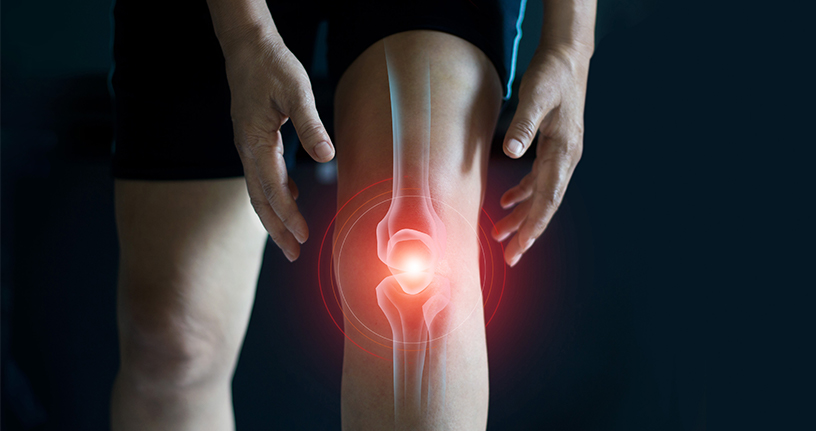Osteoarthritis of the knee is a common health issue. This blog provides information about knee osteoarthritis, the causes of knee syndrome, and how to manage it.
About Osteoporosis
Our joints go through a normal cycle of damage and repair during their lifetime, but sometimes, the body’s process of repairing our joints can cause changes in their shapes or structures. When these changes occur in one or more of your joints, it is called osteoarthritis.
A joint is where two or more bones connect. In your knee, the thigh and shin bones connect. The ends of the bones are covered with a smooth and slippery surface known as cartilage. This causes the bones to move against each other without friction and protects your joints from stress. Our knee has two other rings of a different type of cartilage called meniscus, helping to share weight evenly across your knee joint, and there is also cartilage underneath your kneecap.
Joint disease, osteoarthritis, causes the cartilage in your knee to thin and the joint surfaces to become rougher, which means that the knee can’t move as smoothly as it should and may feel stiff and painful.
Osteoporosis can affect people of any age, but the condition is more common in women over 50. Injuries or other joint issues, including gout, can make people more likely to develop osteoarthritis. The genes inherited by our parents can also elevate the risk of the condition. Being overweight is also associated with osteoarthritis, as this can cause extra strain in your knees that comes under the category of weight-bearing joints.
Osteoarthritis is referred to as degenerative joint disease or wear and tear arthritis. It may result from an injury to the knee earlier in life. Fractures that involve the joint surfaces and instability from ligament tears can also cause abnormal wear and tear of the knee joint. However, not all cases of osteoporosis are associated with prior injury. Clinical studies have demonstrated that some individuals are more likely to develop osteoarthritis, and this tendency may be genetic. The joint disease develops slowly over several years.
The knee osteoporosis symptoms are mainly pain, swelling, and stiffness. The pain usually gets worse after a physical activity. Early in this joint disease, you may observe that your knee becomes painful and stiff. As the disease progresses, pain can affect your daily routine, interfering with even simple activities. Later, the pain can be continuous and affect your sleeping patterns. This pain probably does not arise from the covering of the joint, the articular cartilage, because this tissue does not have nerve supply. There are still some doubts about where the pain in osteoporosis originates from.
Sources of pain may include:
-
- Inflammation that occurs in the lining of the joint called the synovium
- Pressure from blood circulation in the area
- Small fractures in the bones under the cartilage, called subchondral bone
- Loose bone chips in the joints
- Degenerative tears in the meniscus cartilage
Understanding the causes of knee joint pain
Common causes of knee pain that increase your risk of developing osteoporosis include:
Age: The cartilage’s ability to heal itself reduces with age. Knee syndrome and osteoarthritis typically affect people in middle age and older.
Heredity: Certain genes have been associated with osteoarthritis. Inherited traits, including being knock-kneed, bowlegged, or double-joint, can also increase the likelihood of developing joint disease.
Weight: the more your body weight, the more stress you put on your knee.
Injury: Previous knee injury, like sports injury, can contribute to osteoarthritis later in life.
Other medical conditions: If you have had other issues with your knee, such as knee infection, gout, or Lyme disease, your risk for this joint disorder increases.
Overusage: Those in occupations that involve repeated squatting or kneeling, brisk walking, or heavy lifting are vulnerable to repetitive stress injuries in the knee. This may make them more prone to osteoarthritis.
Common treatments
Your healthcare specialist will develop a knee joint pain treatment plan for knee pain relief:
Lifestyle changes: If the pain associated with arthritis in your knee does not interfere with your daily activity, your healthcare specialist may first recommend lifestyle modifications to protect your joints and slow down the progression of the disease. Exercise, Weight loss management, and physical therapy for knee pain can help reduce joint stress.
Medications: Surgery: If your pain interferes with your daily routine or is not effectively relieved by initial methods, you may be advised with acetaminophen, nonsteroidal anti-inflammatory drugs (NSAIDs) like ibuprofen (ibugesic 200 mg, brufen 400 mg tablets), etoricoxib (Nucoxia 90 mg) and aspirin to reduce pain and swelling. You may also be prescribed joint pain cream to reduce stiffness and swelling.


